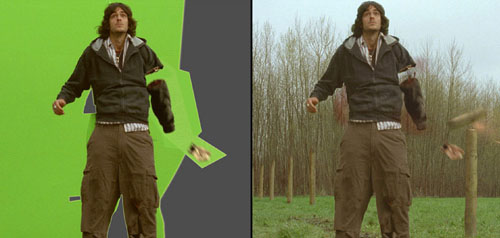The job of breathing “life” into the endless “death” of Final Destination II was awarded to long time Digital Fusion users, Digital Dimension. The visual effects studio completed 85 shots, all of which traveled through DF. Everything from the 4000 frame premonition sequences that aided our star, Miss Rivers, in evading numerous pitfalls, to the action packed log disaster scene, a precursor to the theme of “frightening consequences”.
Hollywood’s obsession with death goes one step further in New Line Cinema’s latest teen thrill ride, Final Destination II. What happens when imminent death is avoided by the narrowest of margins? As the only survivor of “Deaths” earlier fatal pursuit, Clear Rivers (Ali Larter) uses a series of premonitions experienced directly before an upcoming tragedy to avoid her certain demise.
“The premonition sequences are essential to the film, as they provide a framework for the disasters that follow, allowing our star to escape the cold hand of death.” Says Benoit Girard, President, Digital Dimension. Each escape only angers the pursuing terminal force, as more people scheduled to die avoid their ultimate end. This in turn alters the mortal dynamics of planet earth.
Digital Dimension, once again, used DF, as their primary compositing solution to achieve the perfect eerie feel of these future-predicting dreams. Benoit explains, “DF is a necessity when handling a large number of shots in a short period of time. We used the native blur, color correction and grain tools to get the appropriate feel for the premonitions.” The premonitions are an integral part of the film as they depict the horrid events to come. For example, the exciting log disaster sequence seen in the theatrical trailer.
The developing log disaster scene called for a traffic hullabaloo involving a large truck carrying giant logs that, incidentally, loses its cargo setting off an unbelievable chain of events. The logistics of maneuvering stunt vehicles in and around massive bouncing logs was unrealistic, so Benoit and his team of 15 artists created the logs digitally using 3D animation with dynamics.

The events pictured, tipped off by the snapping of a CG chain, depict massive logs exploding off a large truck. Trailing traffic is then forced to reckon with the oncoming fury. “DF’s RPF. support makes 3D element integration easier, allowing us to tweak pre-rendered 3D elements (logs for example) within the 2D environment, saving us time and ultimately money.” says Benoit.
Once the CG logs were created, it was necessary to integrate them into the scene. To achieve the seamless interplay of CG and live action elements, Digital Dimension added shadows, reflections and fluttering debris using native DF tools. Combining all of the CG elements with the live action is the first step, but the attention to detail is what rounds out the visual impact of the finished shot.

“By using the DF shadow tool, as well as pre-rendered CG shadows, the displacement tool for reflections of the logs on the road surface, the 3D Particle Suite to generate some debris created by the logs hitting the pavement and finally a Luma Keyer to allow the debris to interact both in front of and behind the CG logs” Benoit’s team was able to provide menacing logs that interacted perfectly and realistically with the existing live action environment.
The addition of realistic logs was the first issue that needed to be resolved. The next problem was how to integrate the approaching vehicles into the action sequence. The Dimension team took advantage of DF’s ability to sub-frame sample the animation on the roto-splines using camera accurate physics. This allowed the team to add motion blur to a hand roto-scoped motorcycle and rider as they hit the pavement to avoid the oncoming onslaught. This stunt was difficult enough without an actual barrage of logs, thus roto-scoping the scene was essential. “Motion blur is necessary to portray realistic motion, and is achieved, with accuracy, during the actual alpha creation process for an absolute sense of continuity. Being able to do this during the roto-scoping process makes everything a lot easier and more realistic.” explains Benoit.
Another sequence handled by Digital Dimension involved one of the characters getting split into three parts during an explosion hurling barbed wire at a speed and directional accuracy that guaranteed imminent death. “This particular scene was very complex and needed extensive keying, as well as the use of a dummy to achieve the look of the individual getting split into three. The blood splats are DF particles, and the guts required color correction to look appropriately disgusting.”

Throughout the entire post-production process, the team greatly benefited from DF’s Avid OMF support. “Avid OMF support is very useful! The quick swapping of files between Digital Fusion and the Avid allowed our team and the Editor the ability to communicate with maximum efficiency. Not only does the Avid OMF support allow us to work in Avid’s native media, preventing the need to save out to another file format, but we have access to the Avid EDL right within the DF interface – Fantastic!”
“Digital Fusion has been in our facility since the beginning, and has matured into a solid workhorse.” Benoit closes by saying, “When ever we work with film, or tight deadlines for that matter, Digital Fusion is right there getting the work done on time. We have yet to find another desktop compositing application that can compare.”
